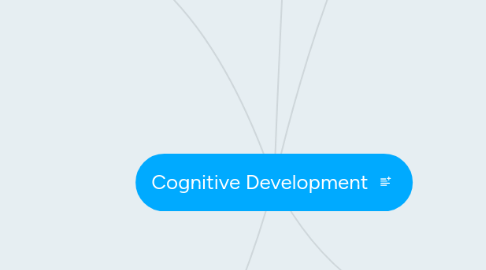
1. 21st Century Learning
1.1. Piaget
1.1.1. Students will be able to understand abstract concepts better if those concepts are related to real-world situations or examples
1.1.2. Letting students in the concrete operational stage use manipulatives to better understand abstract concepts such as fractions (Ormrod, 2014)
1.1.3. Students asked to solve problems by working together in peer groups can create disequilibrium, allowing students to reevaluate their thinking
1.2. Vygotsky
1.2.1. Individualizing instruction can help to keep students with their zone of proximal development
1.2.2. Students should be allowed time for play and games in which they can develop expected behaviors for specific situations
1.2.3. Curriculum can be related to the wider community and culture to assist students in developing a cultural context for the new knowledge
2. Application
2.1. Vygotsky
2.1.1. Cognitive development through play
2.1.1.1. EMT students are presented with a scenario involving emergency care of a patient. The students will model the expected behaviors and duties of an EMT responding to the emergency call.
2.1.1.1.1. Scenarios will provide application of content learned and eventually move the student towards mastery. According to Gredler (2011), Vygotsky believed content and form developed together.
2.1.2. Scaffolding
2.1.2.1. Scaffolding can be used to keep students within the zone of proximal development when intermediate level English language students are learning to make more complex sentence structures
2.1.2.1.1. Actual developmental level
2.1.2.1.2. Scaffolding
2.1.2.1.3. Potential development
2.2. Piaget
2.2.1. Hypothesis and Hands on learning
2.2.1.1. Paramedic students will learn pharmacology and then will be presented with a case study. In the case study, students will form a clinical diagnosis of the patient and suggest which medications should be used to treat the patient. Next, students will act out a scenario in a simulation lab where they will obtain diagnostic information, decide which medication is appropriate, prepare the medication and administer it to the patient. After the simulation, students will participate in a debriefing.
2.2.1.1.1. According to Ormrod (2014), "researchers are finding, however that hands-on experiences are typically more effective when combined with instruction that helps draw appropriate conclusions from what they observed (p. 36)".
2.2.2. Idealism
2.2.2.1. In a lesson about professionalism and the role of emergency personnel, students will be asked to work in small groups to identify 3-5 characteristics they find to be the most important and describe how they do or could portray these characteristics. The groups will read there answers aloud and the class will discuss.
3. Piaget (Ormrod, 2014)
3.1. Children are active and motivated learners
3.2. Learn through assimilation and accommodation
3.2.1. Schemes
3.3. Equilibration
3.3.1. Disequilibrium
3.4. 4 stages of cognitive development
3.4.1. Sensorimotor
3.4.2. Preoperational
3.4.3. Concrete operations
3.4.4. Formal operations
3.5. Constructivism
4. Vygotsky (Ormrod, 2014)
4.1. Sociocultural theory
4.2. Culture guides learning through informal conversations with adults and formal schooling
4.3. Thought and language are interdependent
4.3.1. Self-talk
4.3.2. Inner speech
4.4. Complex thought processes are developed through social activity and gradually adopted into the child's way of thinking
4.4.1. Internalization
4.5. Appropriation of cognitive tools for their own use
4.6. Difficult tasks completed with guidance of more experienced individuals
4.6.1. Actual development level
4.6.2. Level of potential development
4.6.3. Zone of proximal development
4.6.4. Scaffolding
4.7. Cognitive development through play
5. Compare/Contrast (Ormrod, 2014)
5.1. Similar
5.1.1. Complexity of thinking with age and experience
5.1.2. Importance of challenge
5.1.2.1. Piaget
5.1.2.1.1. Disequilibrium
5.1.2.2. Vygotsky
5.1.2.2.1. Zone of proximal development
5.1.3. Children will vary in their placement within a stage of cognitive development
5.1.3.1. Piaget
5.1.3.1.1. Building on existing schemes
5.1.3.2. Vygotsky
5.1.3.2.1. Zone of proximal development will differ for individuals
5.2. Different
5.2.1. Learning
5.2.1.1. Piaget
5.2.1.1.1. Self-exploration and discovery
5.2.1.2. Vygotsky
5.2.1.2.1. Guided exploration and instruction from adults
5.2.2. Culture
5.2.2.1. Piaget
5.2.2.1.1. Not applied
5.2.2.2. Vygotsky
5.2.2.2.1. Directly related to thinking skills developed
5.2.3. Language
5.2.3.1. Piaget
5.2.3.1.1. Labels for mental representation of the world
5.2.3.1.2. Way of gaining knowledge of other's perspectives
5.2.3.2. Vygotsky
5.2.3.2.1. Informal conversations and social interactions lead to internalization of thought processes
5.2.3.2.2. Self-talk and inner speech guide thinking in ways similar to the guidance provided by adults prior

